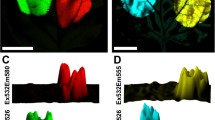Abstract
Green fluorescent protein (GFP) is a popular qualitative reporter protein used to study different aspects of plant biology. However, to be used as a reliable quantitative reporter in expression studies using fluorescence based assays, methods to eliminate interfering endogenous molecules must be considered. Therefore, a standard curve based solid phase fluorescent immunoassay that eliminates the effects of interfering endogenous molecules was developed to quantify the GFP levels in soluble green extracts prepared from plants. Microtiter plates coated with anti-GFP were used to capture GFP from soluble plant extracts, interfering endogenous molecules was eliminated by washing without disturbing the anti-GFP binding of GFP, and then the fluorescence intensity of bound GFP was measured using a spectrofluorometer. We report in this study the use of this method to quantify the expression levels of soluble modified GFP in transgenic Arabidopsis thaliana.




Similar content being viewed by others
Abbreviations
- CaMV:
-
cauliflower mosaic virus
- smGFP:
-
soluble modified green fluorescent protein
- RFUs:
-
relative fluorescence units
References
Billinton N, Knight AW. Seeing the wood through the trees: a review of techniques for distinguishing green fluorescent protein from endogenous autofluorescence. Anal Biochem 2001;291:175–97.
Bradford MM. Rapid and sensitive method for quantitation of microgram quantities of protein utilizing principle of protein-dye binding. Anal Biochem 1976;72:248–54.
Clough SJ, Bent AF. Floral dip: a simplified method for Agrobacterium-mediated transformation of Arabidopsis thaliana. Plant J 1998;16:735–43.
Davis SJ, Vierstra RD. Soluble, highly fluorescent variants of green fluorescent protein (GFP) for use in higher plants. Plant Mol Biol 1998;36:521–8.
De Buck S, Windels P, De Loose M, Depicker A. Single-copy T-DNAs integrated at different positions in the Arabidopsis genome display uniform and comparable b-glucuronidase accumulation levels. Cell Mol Life Sci 2004;61:2632–45.
Haseloff J, Siemering KR, Prasher DC, Hodge S. Removal of a cryptic intron and subcellular localization of green fluorescent protein are required to mark transgenic Arabidopsis plants brightly. Proc Natl Acad Sci USA 1997;94:2122–7.
Hellens RP, Edwards EA, Leyland NR, Bean S, Mullineaux PM. pGreen: a versatile and flexible binary Ti vector for Agrobacterium-mediated plant transformation. Plant Mol Biol 2000;42:819–32.
Hraška M, Rakouskỳ S, Čurn V. Green fluorescent protein as a vital marker for non-destructive detection of transformation events in transgenic plants. Plant Cell Tissue Organ Cult 2006;86:303–18.
Inouye S, Tsuji FI. Aequorea green fluorescent protein—expression of the gene and fluorescence characteristics of the recombinant protein. FEBS Lett 1994;341:277–80.
Köhler RH, Zipfel WR, Webb WW, Hanson MR. The green fluorescent protein as a marker to visualize plant mitochondria in vivo. Plant J 1997;11:613–21.
Mankin SL, Thompson WF. New green fluorescent protein genes for plant transformation: intron-containing, ER-localized, and soluble-modified. Plant Mol Biol Rep 2001;19:13–26.
Remans T, Schenk PM, Manners JM, Grof CPL, Elliott AR. A protocol for the fluorometric quantification of mGFP5-ER and sGFP(S65T) in transgenic plants. Plant Mol Biol Rep 1999;17:385–95.
Richards HA, Halfhill MD, Millwood RJ, Stewart CN. Quantitative GFP fluorescence as an indicator of recombinant protein synthesis in transgenic plants. Plant Cell Rep 2003;22:117–21.
Stewart CN. The utility of green fluorescent protein in transgenic plants. Plant Cell Rep 2001;20:376–82.
Zhou X, Carranco R, Vitha S, Hall TC. The dark side of green fluorescent protein. New Phytol 2005;168:313–22.
Acknowledgments
We thank Dr. Phil Mullineaux and Dr. Roger Hellens at John Innes Centre for providing the pGII0029 vector and the Nottingham Arabidopsis Stock Centre (NASC) for providing the 35S-smGFP clone. We thank Johan R. Lillehaug, Department of Molecular Biology, University of Bergen, for helpful discussions. This work was supported by grants from the Hedmark County in Norway.
Author information
Authors and Affiliations
Corresponding author
Rights and permissions
About this article
Cite this article
Johansen, W., Stenseth, EB. & Wilson, R.C. A Rapid and Sensitive Fluorimetric Protocol for the Quantification of Green Fluorescent Protein in Soluble Protein Extracts from Transgenic Arabidopsis . Plant Mol Biol Rep 25, 45–54 (2007). https://doi.org/10.1007/s11105-007-0006-3
Published:
Issue Date:
DOI: https://doi.org/10.1007/s11105-007-0006-3




